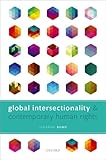Global intersectionality and contemporary human rights / Johanna Bond.
Publisher: Oxford, United Kingdom : Oxford University Press, 2021Edition: First editionDescription: xi, 260 pages ; 24 cmContent type:- text
- 9780198868835
- 341.48
| Item type | Current library | Shelving location | Call number | Status | Notes | Date due | Barcode |
|---|---|---|---|---|---|---|---|
 BOOKs
BOOKs
|
National Law School | General Stacks | 341.48 BON (Browse shelf(Opens below)) | Not For Loan | Recommended by Dr. Akhila Basalalli and Ms. Bhanu Tanwar | 39462 |
Includes bibliographical references and index.
Introduction;
1. Foundations of Intersectionality Theory;
2. Global Application of Intersectionality Theory;
3. Evolution of Intersectionality in the UN Treaty Bodies;
4. Intersectionality and Human Rights within Regional Human Rights Systems;
5. Intersectionality in Treaty Body Decisions;
6. Intersectionality in the State Reporting Process;
7. Putting Intersectionality to Work: Nongovernmental Organizations;
8. Strategies for Reform: Facilitating Intersectionality in Human Rights Advocacy;
Conclusion.
Global Intersectionality and Contemporary Human Rights argues for an expansive definition of human rights, one that encompasses the harm caused by multiple, intersecting forms of subordination. Intersectionality theory posits that aspects of identity, such as race and gender, are mutually constitutive and intersect to create unique experiences of discrimination and subordination. Perpetrators of sexual violence in armed conflict, of example, often target women based on both gender and ethnicity. Human rights remedies that fail to capture the intersectional nature of human rights violations do not offer comprehensive redress to victims.
This title explores the influence of intersectionality theory on human rights in the modern era and traces the evolution of intersectionality as a theoretical framework in the United States and around the world. It draws upon feminist theory and human rights jurisprudence to argue that scholars and activists have under-utilized intersectionality theory in the global discourse of human rights. As the central intergovernmental organization charged with the protection of human rights, the United Nations has been slow to embrace the insights gained from intersectionality theory. This work argues that the United Nations and other human rights organizations must more actively embrace intersectionality as an analytical framework in order to fully address the complexity of human rights violations around the world.

There are no comments on this title.